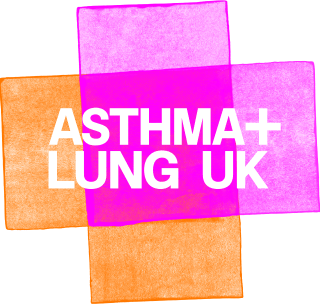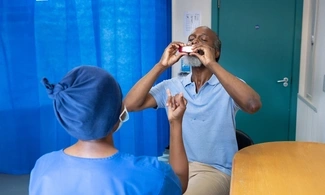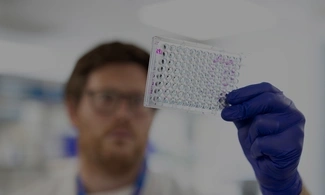What is aspergillosis?
Aspergillosis is caused by breathing in the small spores from aspergillus mould. These spores are usually harmless and easily removed by your immune system. But for some people the spores can cause aspergillosis.
Aspergillosis is not contagious. It’s a rare condition and affects less than 1 in 2000 people.
Aspergillus mould spores are very common and can be found in rotting leaves, crops and other plants and trees. It can also grow in damp housing, carpets, pillows and bedding.
What are the symptoms of aspergillosis?
Symptoms of aspergillosis can include:
- coughing, including coughing up mucus or blood
- feeling breathless
- wheezing (a whistling sound when you breathe)
- chest pain or discomfort
- a high temperature of 38 degrees Celsius or more (fever)
- losing weight without trying
- feeling very tired.
If you already have a lung condition and you get an aspergillosis infection, you may notice your lung condition symptoms get worse.
Who is more at risk of aspergillosis?
Most people who breathe in aspergillus mould do not get ill because their immune system destroys the fungal spores.
You may be more at risk of aspergillosis if you have:
- a lung condition, including asthma, chronic obstructive pulmonary disease (COPD), bronchiectasis or cystic fibrosis
- a weakened immune system, for example if you’ve had an organ transplant, or are having chemotherapy
- had TB (tuberculosis) or NTM infection (non-tuberculous mycobacterial)
- had severe flu, or COVID-19 or pneumonia, especially if you needed intensive care and were treated with mechanical ventilation (a breathing machine)
- take long-term steroids and antibiotics.
See your GP if:
- you’ve had a cough for more than three weeks
- your lung condition is getting worse or is harder to control with your usual treatment
- you have a weakened immune system and symptoms of aspergillosis.
Types of pulmonary aspergillosis
There are different types of aspergillosis. The type of aspergillosis which affects the lungs is known as pulmonary aspergillosis.
The main types of pulmonary aspergillosis are:
- Allergic bronchopulmonary aspergillosis (ABPA)
- Severe asthma with fungal sensitisation (SAFS)
- Chronic pulmonary aspergillosis (CPA) and aspergillomas
- Invasive pulmonary aspergillosis (IPA)
- Aspergillus bronchitis
Allergic bronchopulmonary aspergillosis (ABPA)
Allergic bronchopulmonary aspergillosis is an allergic reaction to aspergillus mould. It mostly affects people with asthma and can lead to symptoms getting worse or an asthma attack. It can also affect people with cystic fibrosis.
Severe asthma with fungal sensitisation (SAFS)
Some people with severe asthma are sensitive to aspergillus mould. This is known as severe asthma with fungal sensitisation (SAFS).
Chronic pulmonary aspergillosis (CPA) and aspergillomas
Chronic pulmonary aspergillosis (CPA) is a long-term aspergillosis infection.
Most people diagnosed with CPA have damage to their lungs caused by a lung condition like COPD, bronchiectasis, sarcoidosis or cystic fibrosis.
You may also be at risk if you’ve had lung cancer, TB (tuberculosis) or non-tuberculous mycobacterial (NTM) infections.
CPA can also lead to aspergillomas. An aspergilloma is a ball of mould that forms in areas of your lungs that have been damaged. This damage may be caused by your lung condition or an infection like TB (tuberculosis).
Aspergillomas can sometimes cause symptoms like coughing up blood, although not always.
Invasive pulmonary aspergillosis (IPA)
Invasive pulmonary aspergillosis (IPA) is when the fungal infection has spread into the lung tissue. It mainly affects people with very weakened immune systems.
IPA is the most serious type of aspergillosis and can be life-threatening.
Aspergillus bronchitis
Aspergillus bronchitis is an infection in the large airways (bronchi).
If you’ve had a chest infection that’s gone on for a long time and antibiotics have not helped, doctors may want to test for aspergillus bronchitis. You’re more likely to get aspergillus bronchitis if you have bronchiectasis or cystic fibrosis. Treating the infection with antifungal medicines works well.
How is aspergillosis diagnosed?
Allergy tests can show if you’re allergic or sensitive to aspergillus mould. However, this does not always mean that you have aspergillosis.
If your test results show you are allergic or sensitive to aspergillus mould, you may need to see a specialist for more tests. These could include:
- x-rays and scans to look at your chest and lungs
- tests on a sample of your mucus, sputum or lung fluid.
- blood tests which look for signs of invasive fungal infections.
- a bronchoscopy to look inside your lungs.
It can sometimes take time to get a diagnosis because symptoms can be similar to other lung conditions and chest infections.
How is aspergillosis treated?
With the right treatment and lifestyle changes, most people can manage aspergillosis and improve their quality of life. Looking after your existing lung condition is important too, and can help to lower your risk of aspergillosis complications.”
Dr Andy Whittamore, Asthma + Lung UK’s GP.
Aspergillosis treatments can include antifungal medicines, steroids, biologics and, in some cases, surgery. Treatment depends on the type of aspergillosis you have.
It’s important to treat aspergillosis as soon as possible to stop it spreading or getting worse.
Without treatment it can lead to:
- lung scarring (fibrosis)
- more symptoms, like coughing and breathlessness
- losing weight
- coughing up blood
- the infection spreading to other parts of your body.
Like all medicines, antifungal medicines and steroids can have side effects, but not everyone will get them. Always check the patient information leaflet that comes with your medicine.
Talk to your healthcare professional if you’re worried about any side effects.
Antifungal medicines
Antifungal medicines are the main treatment for all types of aspergillosis. They kill the fungus and prevent it from growing again. Antifungal medicines need to be taken for weeks, months, or sometimes, even longer.
Always take the full course of antifungal medication prescribed by your doctor. This helps prevent antifungal resistance. This can happen when aspergillus strains becomes resistant to medications.
Antifungal medicines can react with other medicines. Make sure doctors know about any other medicines you take, including steroids, and medicines for high blood pressure or high cholesterol.
Steroids
If you have allergic bronchopulmonary aspergillosis (ABPA), your doctor may prescribe steroid tablets with or without antifungal medicines. Steroids treat inflammation in your airways.
Some people who take steroids for a long time may need a steroid card in case of emergencies. It depends on how much steroid medicine you’re taking, and for how long. Check with your doctor or specialist if you need to carry a steroid card.
Antifungal medicines can react with steroid medicines. Your doctor or specialist can make sure you’re taking both medicines at a safe dose.
Biologics
Some people with allergic bronchopulmonary aspergillosis or severe asthma fungal sensitisation (SAFS) may be offered treatment with a biologic (monoclonal antibody).
This is a specialist treatment given by injection in hospital. It can work very well for some people, improving symptoms and avoiding the need for long-term steroids.
Medical procedures
Your doctors may suggest surgery to remove an aspergilloma if you’re coughing up blood. This will only be if medicines are not helping, and if you’re fit and well enough for an operation.
Bronchial artery embolisation is sometimes recommended if someone is coughing up blood a lot. This is a procedure that blocks abnormal arteries supplying blood to your lungs.
Airway clearance techniques
Airway clearance techniques help to clear mucus from your airways, reduce coughing, and lower your risk of infection.
It’s important to make them part of your daily routine if you produce a lot of mucus. A respiratory physiotherapist can show you the techniques best for you. They may also recommend an airway clearance device.
Living well with aspergillosis
- Quit smoking. Smoking damages the lungs and makes it harder for the body to fight off infections like aspergillosis.
- Stay as active as you can. Exercise keeps your lungs healthy.
- Get your flu vaccine every year, and COVID-19 boosters if you’re eligible.
- Look after your mental health and wellbeing.
How can I avoid aspergillus mould?
Aspergillus mould spores are in the air all around us, so it’s impossible to completely avoid breathing them in.
But if you have a lung condition, a weakened immune system, or are allergic to the spores, it’s worth trying to lower your risk of breathing them in where possible.
Here are a few things to try:
- Avoid compost heaps, rotting leaves or decaying plant material.
- Wear a protective facemask if you need to work in the garden. Thrive has more advice on gardening with a lung condition.
- Avoid gardening or spending time outside when fungal spores are worse, like in the autumn. You’re less likely to be affected in the summer months.
- Keep your home dry and well ventilated. Opening windows will help prevent damp and mould caused by steam from cooking or showers.
- Avoid drying washing inside if you can because this causes condensation and damp. If you do have to dry washing inside, open windows when you can and avoid hanging it on radiators.
- Keep your home heated between 18 to 21 degrees Celsius in cold weather.
Find out more about improving indoor air quality.
Further support
- Aspergillus and Aspergillosis has detailed information about aspergillus fungus and aspergillosis.
- The Aspergillus Trust aims to raise awareness of the condition. It has patient information leaflets and posters, and links to further support.

Get support
Our helpline is closed from 1pm on Wednesday 24th December 2025 and re-opens at 9:15am on Friday January 2nd 2026. Our supporter care line is also unavailable during this period. If you have a flare-up of your lung condition symptoms, contact your GP or healthcare professional or 111 for advice. Always dial 999 in an emergency.








